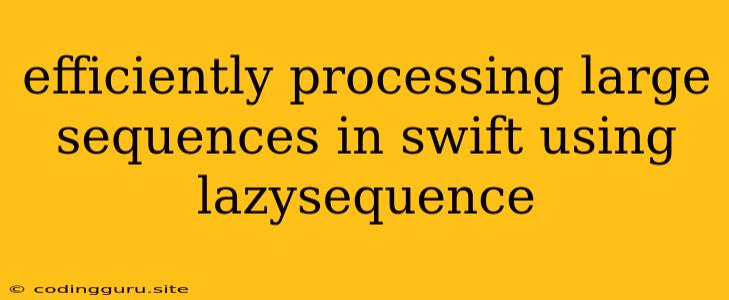Efficiently Processing Large Sequences in Swift Using LazySequence
Working with large sequences of data in Swift can pose a challenge, especially when performance is critical. Traditional approaches to iterating through large sequences can lead to memory issues and slow execution times. Fortunately, Swift provides a powerful tool to handle this: LazySequence.
What is a LazySequence?
A LazySequence in Swift is a sequence that defers its element computation until it is absolutely necessary. This means that elements are only calculated and stored in memory when they are actually accessed, rather than upfront. This lazy evaluation approach has significant benefits when working with large datasets:
- Reduced memory footprint:
LazySequenceavoids storing the entire sequence in memory at once. It only keeps the elements that are actively being processed, which can be crucial for large datasets that would otherwise exhaust memory. - Improved performance: By deferring element computation,
LazySequenceavoids unnecessary processing of elements that might not be required. This can dramatically speed up operations on large sequences, particularly those involving filtering, mapping, or other transformations.
How to Use LazySequence
Let's explore how to leverage LazySequence to process large data efficiently:
-
Creating a
LazySequence: You can convert any sequence to aLazySequenceusing the.lazyproperty. For example:let numbers = [1, 2, 3, 4, 5, 6, 7, 8, 9, 10] let lazyNumbers = numbers.lazy -
Chaining Operations: The magic of
LazySequencelies in its ability to chain operations. You can apply transformations likemap,filter,prefix,suffix, and others to aLazySequencewithout immediate computation.let evenNumbers = lazyNumbers.filter { $0 % 2 == 0 } -
Accessing Elements: To access individual elements of a
LazySequence, you can use a loop orforEachclosure. Elements are computed only when accessed.for number in evenNumbers { print(number) }
Example: Processing a Large File
Let's imagine you have a large text file containing millions of lines. You need to extract all the lines that contain a specific word and count them. Here's how you can do it efficiently using LazySequence:
func countLinesContainingWord(filename: String, word: String) -> Int {
let fileURL = URL(fileURLWithPath: filename)
let fileContents = try String(contentsOf: fileURL)
let lines = fileContents.components(separatedBy: "\n").lazy // LazySequence of lines
return lines
.filter { $0.contains(word) } // Filter for lines containing the word
.count
}
let wordCount = countLinesContainingWord(filename: "large_file.txt", word: "example")
print("Number of lines containing 'example': \(wordCount)")
In this example, we read the file contents into a string and create a LazySequence of lines. Then we filter the LazySequence for lines containing the word "example" and finally count the matching lines. This approach avoids loading the entire file into memory at once, significantly improving performance for large files.
Conclusion
Using LazySequence is a powerful technique for efficient processing of large sequences in Swift. By deferring computation and avoiding unnecessary memory allocation, LazySequence enables you to work with large datasets while maintaining performance and conserving resources. Remember to embrace LazySequence whenever you encounter scenarios involving extensive processing of large sequences, and your Swift code will thank you.
